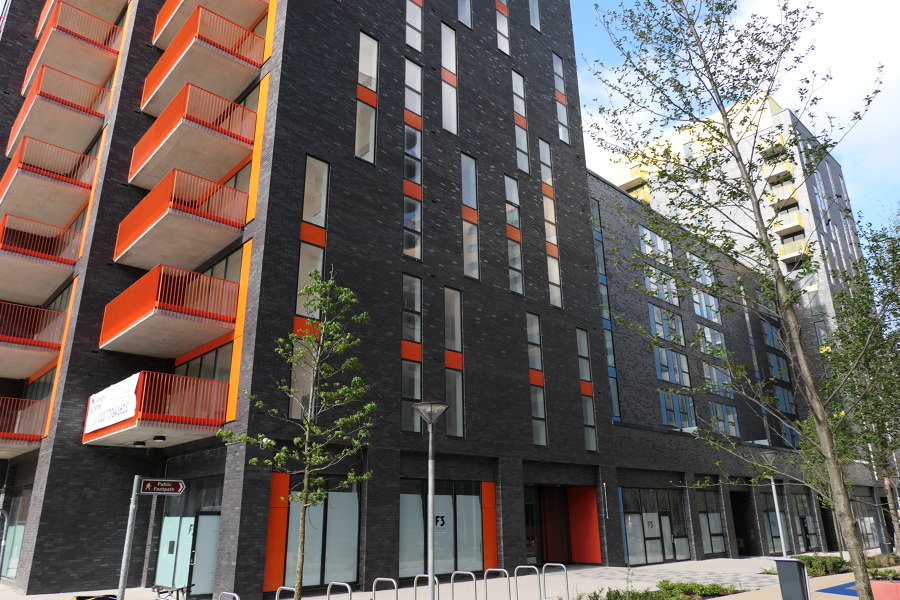The late Prof. Will Alsop’s practice, aLL Design, has completed a 138-apartment building in London’s Docklands. EPR Architects were responsible for RIBA stages A-C and aLL Design for RIBA stages C to completion.
45 Millharbour is located on the Isle of Dogs at Millwall Inner Dock, a designated Water Protection Area. This large expanse of water is a dominant characteristic of the area and provides the local community with a unique recreational and amenity space.
The building is divided into four blocks; the two tallest (14 storeys) are situated to the east and west of the development and comprise both privately owned and shared ownership units, the eastern block overlooks the dock and boasts beautiful views of the water. The opposite tower faces back to the city with extraordinary views of London's skyline and famous landmarks. The two central blocks comprising affordable flats and duplexes for Network Homes reach seven storeys in height.
The building provides 138 apartments with commercial units on the ground floor including serviced offices and a cafe, which create active frontages. A landscaped amenity space links Millharbour Road with the Millharbour Inner Dock providing an attractive green public space including play space and bike racks for locals and residents. A new public route snakes through the site to the dockside. Most units have generously proportioned private balconies or terraces and access to a large roof terrace at 7th floor level.
aLL Design were initially appointed post-planning to review the efficiency of the floorplate and were able to add 348sqm of net living area without increasing the external envelope of the building, increasing the efficiency of the floor plate from 80% to 82.5%. Balconies were increased in size to comply with the London Housing Design Standards and the building design was developed to meet Secure by Design Standard, Lifetime Homes, Code for Sustainable Homes Level 4 and BREEAM Excellent. Materials were re-sourced to improve fire performance and the appearance of the building. Kalwall, unsuitable for use above 18m, was changed to Reglit, and Trespa panels coupled to windows were changed to non-combustible PPC Solid Aluminium Velfac Panels. Grey balustrades were changed to match the accent colours of each tower and the striking Hagemeister brick was specified.
These changes were resubmitted for planning approval. Two different Hagemeister bricks have been used together Alt Berlin & Dallas; a dark grey and a lighter grey with iridescent coating which are mixed in contrasting ratios on the towers and lower building. Windows are floor to ceiling, high performance; PPC Aluminium-clad, timber coupled to brightly coloured PPC Aluminium insulated panels. A different accent colour is designated to each block; yellow, orange and powder-blue which contrast with the grey brickwork.
The top floors of the towers are clad with coloured panels. Balcony balustrades have brightly coloured PPC vertical fin railings along the edge of exposed concrete balcony slabs. Each block has its own entrance and lobby area, the towers have brightly coloured resin floors, Corian reception desks and Letter Boxes to match the building accent colours and are again set against a deep grey wall and ceiling colour.
The basement houses a 42-space car park, small gym, cycle stores and plant rooms. PRS and shared ownership apartments have underfloor heating and engineered timber floors.
All apartments have low water consuming sanitary ware, low energy appliances, MVHR units and excellent levels of insulation and airtightness to minimise the requirement for water and energy consumption. The building is connected to a local district heating system and collects rainwater for irrigation in underground tanks. There are PV panels on the tower roofs along with an area of brown roof to support biodiversity and an area of relocated Jersey Cudweed, a very rare plant with just two surviving populations in Britain which was discovered on site in the early ecological surveys. The brick elevations incorporate swift and bat boxes. During construction landscape materials were delivered to site by barge to reduce road traffic and associated pollution.
Design Team:
aLL Design
Architect (RIBA Stages A-C): EPR
Architect (RIBA Stages C+-Completion): aLL Design
Landscape: Macfarlane Associates























